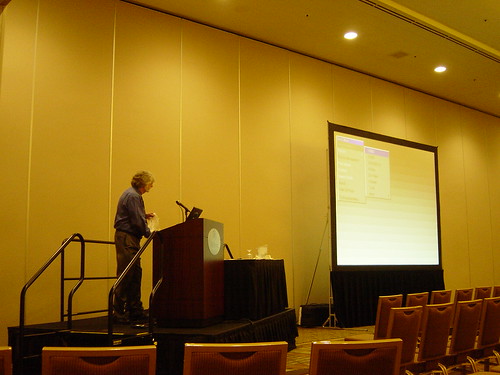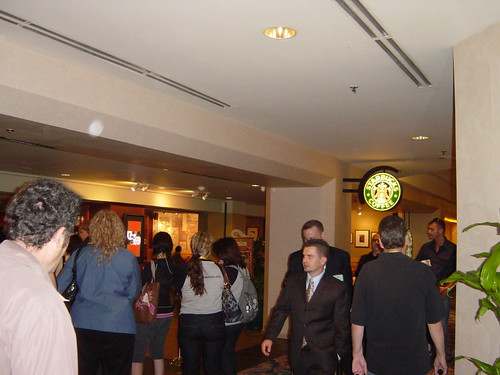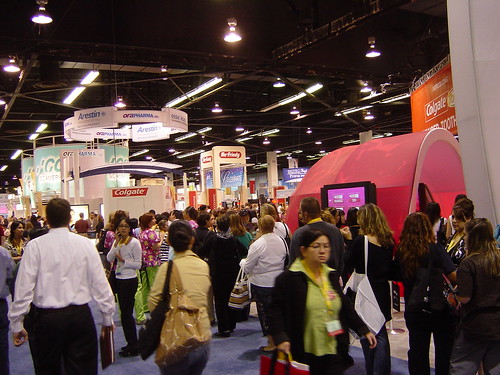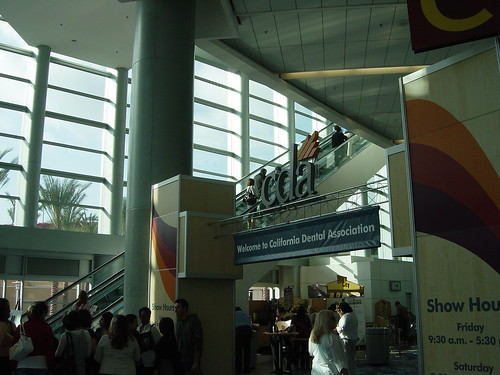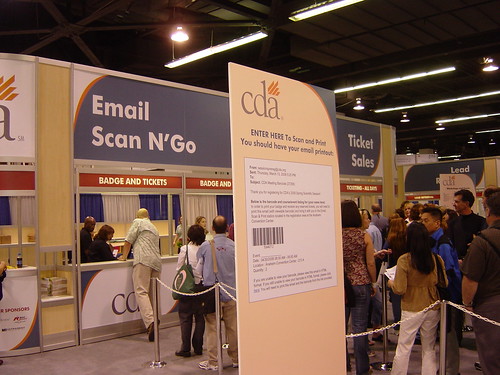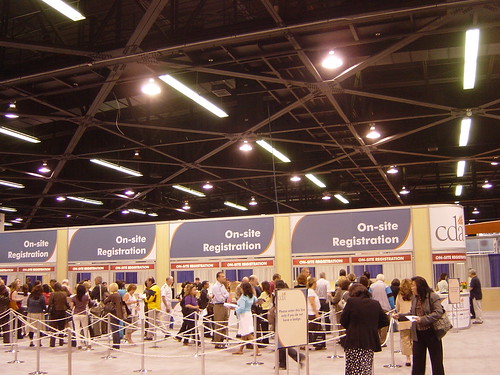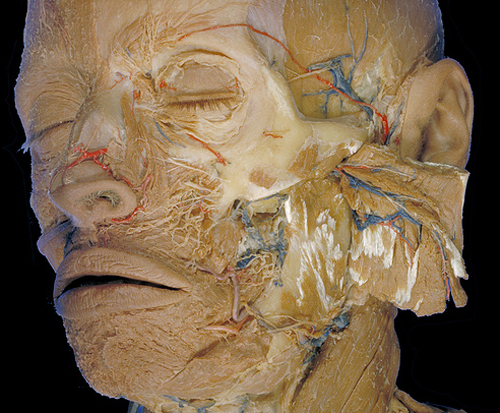-
Day By Day by Chris Muir May 4, 2008
Flap has blown off the last day of the California Dental Association (CDA) Convention in Anaheim. The
astutestupid organizers ONLY allocate one segment of continuing education and close the exhibit hall at 2 PM.CDA leadership must re-think their schedule if they wish to attract commuting dentists from Southern California and make Sunday a worthwhile day for the commercial businesses that sponsor the show.
There is certainly NOT sufficient time to take classes and then see some of the latest dental products and equipment – and then to have fun with the family and staff? Too much of a challenge – even for the most energetic of practitioners.
Related:
Flap @ California Dental Association Meeting May 3, 2008
Flap @ California Dental Association Meeting May 2, 2008
Flap @ California Dental Association Meeting May 1, 2008
Previous:
-
Flap @ California Dental Association Meeting May 3, 2008
Flap arrived at the Anaheim Hilton and the California Dental Association Convention in record time this morning. The freeways were remarkably clear and the speeding went well @ 75-85.
Parking in the main lot was easy and smooth. I suspect most everyone will sleep in and crush the place around 10 or so. But, who knows? Maybe the staff and dentists came out yesterday?
Flap’s complete CDA photo stream on Flickr is here – updated throughout the day.
My next course will be at 10 AM.
The class is Crystal Methamphetamine: Your Teeth, Your Health, Your Life presented by Mitchell A. Goodis, D.D.S.
His website is here: mitchtv.net
And, here is part one of his video series on You Tube:
[youtube]http://youtube.com/watch?v=uyS6r7G5dOo[/youtube]
Meth mouth is real and this is what it looks like. This group of videos is currently used in many schools, police departments, and county support agencies.
THESE PEOPLE ARE REAL. Most came to our dental office to have teeth extracted, mostly due to use of Crystal Meth. Let’s work together to keep our kids off this devastating and brutal drug.
-
Flap @ California Dental Association Meeting May 2, 2008
Paul Feurstein, DMD – New Technology for the Dental Practice: http://www.computersindentistry.com
Flap arrived in Anaheim after an easy 90 minute drive but the parking was slamming – as usual. At 8 in the morning the main parking lot adjacent to the Convention Center was filled and I was directed to the auxiliary lot behind some of the Exhibit Halls.
Note all of the dentists waiting for the tram and the massive containers filled with dental equipment. Flap did not wait for the tram
And, here was the longest line of the morning:
Starbucks @ Anaheim HiltonOk, onto Paul’s class
Flap’s complete CDA photo stream on Flickr is here – updated throughout the day.
Update:
Part two of the course will start shortly. Flap has uploaded lunchtime photos from the CDA Exhibit Hall here.
And, Flap will be live twittering the course in the right sidebar —> or follow Flap on Twitter.
-
Flap @ California Dental Association Meeting May 1, 2008
Flap arrived in Anaheim from Thousand Oaks in about 90 minutes which is not bad considering I had to travel through downtown Los Angeles.
The parking was, of course, jammed and expensive ($12). Wonder who owns the parking concession for the Anaheim Convention Center?
Registration was long with lines for all of us CDA’ers who did not pay our dues sufficiently in time to receive mailed credentials and badges. The online registration line was longer than the manual one. I chose the shorter line.
Off to my first class……..
More later and the complete photostream on Flickr is here.
-
US FDA Approves for Marketing a New Natural Rubber Latex for Dental Gloves and Dams

Dr. Katrina Cornish examines Guayule seedlings while at USDA
From the American Dental Association: FDA issues market clearance for new form of latex glove
The U.S. Food and Drug Administration cleared for marketing a patient examination glove made from a new form of natural rubber latex, the first approval of a device derived from a desert plant native to the Southwestern United States. The FDA regulates medical-dental devices.
“This approval has the potential to make a significant difference to both the general public and the medical community at large,” said Daniel Schultz, M.D., director of FDA’s Center for Devices and Radiological Health. “Gloves made from guayule latex may prove to be a safer alternative for some people with sensitivity to traditional latex. And yet they will not sacrifice the desirable properties of traditional latex such as flexibility and strength.”
American Dental Association latex allergy notices for the profession and patients are posted at www.ada.org under Oral Health Topics. The ADA Web site also includes information on hand hygiene and glove use and skin care and lotion use with latex gloves. “Some dental healthcare workers have developed hypersensitivity to proteins derived from natural rubber latex used in certain medical and dental devices, including examination and surgical gloves,” says an ada.org notice on personal protective equipment. “These workers should use PPE made of an alternative material.” Patients are encouraged to advise the dental office staff “if you have had a prior allergic reaction to latex-containing objects.”
The FDA-approved product, the Yulex Patient Examination Glove, is derived from the guayule bush, a desert plant native to the Southwest. The Yulex Corp., Maricopa, Ariz., said in a press release that examination gloves made with patented Yulex natural rubber, and cleared by the FDA, do not contain proteins associated with allergic reactions to latex products. Traditional latex gloves are made from the milky sap of a rubber tree.
Flap has been fortunate that he has never experienced (first hand – sorry for the bad pun) a latex allergy to gloves. But, I have seen it for others, including dentists, assistants, hygienists and patients. The use of other glove substitutes do not provide the snugness of fit like latex.
Flap is looking forward to the distribution of this product. But, will they be able to ramp up production to satisfy demand?
The website for the Yulex Corporation is here.
-
The Hospitalist – Physicians Get a Life
The link to the video at the WSJ is hereAn interesting trend in medicine that Flap is also seeing in dentistry. The days of the solo family practitioner in medicine or dentistry are thankfully over.
• New Generation: Young doctors are pushing to balance work and family life.• Changing Medicine: Practices are adapting by creating new, more flexible schedules.• For Patients: Doctors may be less exhausted, but also less familiar.In dentistry there are more group practices with specialists “in house.” Patients will receive more coordinated multi-discipline care. Often, the junior associate dentists relieve senior partners of “on call” duty.
But, since dentistry is NOT hospital based, a group practice model to replace baby-boomer solo general practices may be slower to evolve.
-
Stereoscopic 3 D Atlas of Human Anatomy to Go Online
After the removal of an outer layer of bones around the jaw, the dissection shows blood vessels and sensory nerves to the lower teeth and chin. The process was slow, in part because the Kodachrome film had to be sent to Kodak in Rochester, N.Y., to be developed. Mr. Gruber had to check that the photos came out satisfactorily before Dr. Basset could proceed with his dissection. Photo courtesy of New York Times
This amazing and wonderful work on human anatomy in three dimensions will soon be online thanks to Stanford University.
Dr. David L. Bassett, was an expert in anatomy and dissection at the University of Washington. For more than 17 years, he was engaged in creating what has been called the most painstaking and detailed set of images of the human body, inside and out, ever produced. In 3-D.
Working closely with William Gruber, the inventor of the View-Master, the three-dimensional viewing system that GAF Corporation popularized as a toy in the 1960s, Dr. Bassett created the 25-volume “Stereoscopic Atlas of Human Anatomy†in 1962. It included some 1,500 pairs of slides, along with line drawings that made the details more discernible. The paired slides could be examined with a View-Master, making the chest cavity look cavernous, and making details of structure and tissue stand out unforgettably.
The atlas was an immediate success and the images became an important resource for medical students, even more so as schools have de-emphasized gross anatomy and cadaver work. But the atlas eventually went out of publication in the 1960s.
Thanks to Stanford University’s school of medicine, however, the work will soon be available to the world. The school is bringing the images online, (See a sampling.). The school has also worked with eHuman, a company in Silicon Valley that hopes to charge students and the curious for access to the trove. Rolling a computer mouse over an image at the eHuman site will highlight anatomical details, and bring up the line drawings from the atlas. So far access to the head and neck collection is $8 a month. Nothing else is online yet.
The Bassett Collection on Flickr is here.
Access to The Bassett Online anatomical collection can be purchased here. This isa must purchase for dental students, researchers and clinicians alike.
The masseter muscle of mastication reflected back to expose the jawbone (mandible) and the related vessels, nerves and muscles.
-
Dental Therapists an Answer to Access to Care?

Aurora Johnson, left, a dental therapist, filled cavities for Paul Towarak, 10, in the village of Unalakleet, Alaska. For more involved procedures, Ms. Johnson refers patients to a dentist. Photo courtesy of New York Times
Less training is not an answer. Dentistry is a complex and difficult profession that is MORE than extracting and filling a few teeth.If the dental therapists must have two years of training, how is that different than a three year program at an American Dental School?
Answer: One year of training
And, that solves access to care or the cost of dental care how?
-
CDC Says Lead Levels in Dental Crowns Are a “Highly Unlikely†Health Risk to Adults

A sample of the crown and bridge work available from China Dental Outsourcing
From the American Dental Association:
When news of lead contamination in an outsourced dental crown hit the presses in late February, the ADA called on the nation’s leading health agencies to address safety concerns raised by the reports. Association leaders are gratified by their responses.
The CDC explained that the level of lead reported in the crown in the media reports —approximately 200 parts per million—is “highly unlikely” to be a health risk to an adult.
“Such small amounts of lead as reported, are extremely unlikely to cause adverse health effects in adults,” the Centers for Disease Control and Prevention told the ADA in its response. “Given the current information, CDC does not recommend that individuals defer needed oral procedures or have existing prostheses removed.”
That said, the CDC noted that it recommends against the unnecessary use of lead in consumer products, including dental crowns.
“I’m relieved that the CDC sees no threat to patients based upon the trace amount of lead reported,” said ADA President Mark Feldman. “We are still conducting our own test of dental prostheses and are gratified that CDC has offered to interpret any health impact of the results”.
So, patients will NOT need crowns which have been outsourced to China replaced. But, how would they ever know if their crowns or other prostheses have been made overseas in the first place – and to what standards.
Flap bets there will be state by state legislation requiring disclosure by dentists to their patients on where their prostheses are manufactured and the materials used.
In the meantime, outsourcing will continue but with increasing scrutiny by the feds and the protestations of American dental laboratories and patients alike.
-
Heartland Dental Pays $3 Million to Settle Medicaid Fraud Charges
Heartland Dental of Effingham, Illinois
A whistleblower law suit was the start of Heartland Dental’s difficulties with the state of Illinois and the Feds.
An Effingham-based company that manages dental practices in Springfield, Lincoln, Litchfield and dozens of other Illinois communities will pay more than $3 million to resolve allegations of Medicaid fraud and improper prescription writing that arose from a federal whistle-blower lawsuit.
The settlement, involving Heartland Dental Inc. and Heartland chief executive officer Richard E. Workman, was announced Friday by the Springfield office of Rodger Heaton, U.S. attorney for the Central District of Illinois.
Heartland Dental denied any wrongdoing as part of the civil settlement, and Deborah Gersh, one of the company’s lawyers, noted that federal officials made no allegations that any dental procedures were performed unnecessarily or caused any harm to patients.
In the first of civil settlements to resolve the allegations, Heartland agreed to pay $1.65 million — $990,000 to state government and $660,000 to the federal government — to resolve allegations of improper billings to Illinois’ Medicaid program.
In a related settlement, Heartland agreed to pay the federal government $1.35 million to resolve allegations that newly hired dentists in Illinois and other states issued prescriptions for painkillers and antibiotics before those dentists underwent the required federal registration.
According to the U.S. attorney’s office, the first settlement resolved allegations that Heartland submitting claims to Medicaid for tooth restorations when the procedures performed were actually “crown buildups,†which don’t qualify for coverage.
It also was alleged that the company wrongly billed Medicaid tooth extractions as “surgical extractions†— procedures that resulted in higher payments.
Federal officials said the alleged improper Medicaid bills took place from 1999 through October 2005.
How difficult is it to obtain a DEA license? Not very but you have to be dentally licensed and pass the background check. Is Heartland’s credentialing that lacking? Or was it a deliberate oversight?
And, the issue of overbilling Medicaid always seems to be a continual problem for large providers of welfare dentistry. When the government pays, why not game the system? Illinois and Indiana have more generous welfare payments for dentistry as compared to California and other western states.
Under the terms of federal and state laws that encourage citizens to report fraud and allow them to be rewarded, former Heartland employee Lori Jamison will receive $412,500 from the federal government’s $660,000 settlement.
Jamison also will be paid an additional $325,000 by Heartland to take care of her attorney’s fees and related costs.
Jamison, who used to work for one of the companies that merged in 2006 to form Heartland, filed a whistle-blower lawsuit in 2003. That suit, which had been sealed, was unsealed and dismissed Friday in Springfield’s U.S. District Court.
Flap’s advice to dentists (particularly new graduates) is to know who you are working for and scrutinize the billing if you are a Medicaid provider. After all, it is your license to practice that may be affected.



